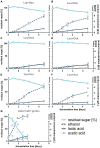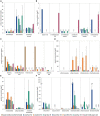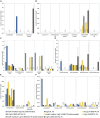Tradition as a Stepping Stone for a Microbial Defined Water Kefir Fermentation Process: Insights in Cell Growth, Bioflavoring, and Sensory Perception
- PMID: 35910583
- PMCID: PMC9336596
- DOI: 10.3389/fmicb.2021.732019
Tradition as a Stepping Stone for a Microbial Defined Water Kefir Fermentation Process: Insights in Cell Growth, Bioflavoring, and Sensory Perception
Abstract
A process development from a traditional grain-based fermentation to a defined water kefir fermentation using a co-culture of one lactic acid bacterium and one yeast was elaborated as a prerequisite for an industrially scalable, controllable, and reproducible process. Further, to meet a healthy lifestyle, a low ethanol-containing product was aimed for. Five microbial strains-Hanseniaspora valbyensis, Dekkera bruxellensis, Saccharomyces cerevisiae, Liquorilactobacillus nagelii, and Leuconostoc mesenteroides-were used in pairs in order to examine their influence on the fermentation progress and the properties of the resulting water kefir products against grains as a control. Thereby, the combination of H. valbyensis and L. mesenteroides provided the best-rated water kefir beverage in terms of taste and low ethanol concentrations at the same time. As a further contribution to harmonization and reduction of complexity, the usage of dried figs in the medium was replaced by fig syrup, which could have been proven as an adequate substitute. However, nutritional limitations were faced afterward, and thus, an appropriate supplementation strategy for yeast extract was established. Finally, comparative trials in 5-L scale applying grains as well as a defined microbial consortium showed both water kefir beverages characterized by a pH of 3.14, and lactic acid and aromatic sensory properties. The product resulting from co-culturing outperformed the grain-based one, as the ethanol level was considerably lower in favor of an increased amount of lactic acid. The possibility of achieving a water kefir product by using only two species shows high potential for further detailed research of microbial interactions and thus functionality of water kefir.
Keywords: bioflavoring; co-culture; lactic acid bacteria (LAB); process development; water kefir; yeast; yeast extract.
Copyright © 2021 Köhler, Schmacht, Troubounis, Ludszuweit, Rettberg and Senz.
Conflict of interest statement
The authors declare that the research was conducted in the absence of any commercial or financial relationships that could be construed as a potential conflict of interest. The reviewer SJ declared a shared affiliation with one of the authors MSc, to the handling editor at time of review.
Figures









Similar articles
-
Shotgun Metagenomics of a Water Kefir Fermentation Ecosystem Reveals a Novel Oenococcus Species.Front Microbiol. 2019 Mar 13;10:479. doi: 10.3389/fmicb.2019.00479. eCollection 2019. Front Microbiol. 2019. PMID: 30918501 Free PMC article.
-
Oxygen and diverse nutrients influence the water kefir fermentation process.Food Microbiol. 2018 Aug;73:351-361. doi: 10.1016/j.fm.2018.02.007. Epub 2018 Feb 13. Food Microbiol. 2018. PMID: 29526223
-
Investigation of the instability and low water kefir grain growth during an industrial water kefir fermentation process.Appl Microbiol Biotechnol. 2017 Apr;101(7):2811-2819. doi: 10.1007/s00253-016-8084-5. Epub 2017 Jan 9. Appl Microbiol Biotechnol. 2017. PMID: 28070662
-
An update on water kefir: Microbiology, composition and production.Int J Food Microbiol. 2021 May 2;345:109128. doi: 10.1016/j.ijfoodmicro.2021.109128. Epub 2021 Mar 3. Int J Food Microbiol. 2021. PMID: 33751986 Review.
-
Water kefir: Factors affecting grain growth and health-promoting properties of the fermented beverage.J Appl Microbiol. 2022 Jul;133(1):162-180. doi: 10.1111/jam.15385. Epub 2021 Dec 20. J Appl Microbiol. 2022. PMID: 34822204 Review.
Cited by
-
The Production of Water Kefir Drink with the Addition of Dried Figs in the Horizontal Rotating Tubular Bioreactor.Foods. 2024 Sep 6;13(17):2834. doi: 10.3390/foods13172834. Foods. 2024. PMID: 39272599 Free PMC article.
-
The core microbiomes and associated metabolic potential of water kefir as revealed by pan multi-omics.Commun Biol. 2025 Mar 11;8(1):415. doi: 10.1038/s42003-025-07808-3. Commun Biol. 2025. PMID: 40069560 Free PMC article.
-
Recent advances in yeast and bacteria co-cultivation for bioprocess applications.World J Microbiol Biotechnol. 2025 May 9;41(5):170. doi: 10.1007/s11274-025-04385-9. World J Microbiol Biotechnol. 2025. PMID: 40341666 Review.
-
Antioxidant and anti-inflammatory properties of water kefir microbiota and its bioactive metabolites for health promoting bio-functional products and applications.AIMS Microbiol. 2024 Sep 5;10(4):756-811. doi: 10.3934/microbiol.2024034. eCollection 2024. AIMS Microbiol. 2024. PMID: 39628717 Free PMC article. Review.
-
The Influence of Pichia kluyveri Addition on the Aroma Profile of a Kombucha Tea Fermentation.Foods. 2023 May 10;12(10):1938. doi: 10.3390/foods12101938. Foods. 2023. PMID: 37238757 Free PMC article.
References
-
- Açik M., Çakiroðlu F. P., Altan M., Baybo T. (2020). Alternative source of probiotics for lactose intolerance and vegan individuals: sugary kefir. Food Sci. Technol. 40 523–531. 10.1590/fst.27919 - DOI
-
- Analytica-EBC (1997). Methods 9.39 Dimethyl Sulphide and Other Lower Boiling Point Volatile Compounds in Beer by Gas Chromatography (2000). Nürnberg: Hans Carl.
LinkOut - more resources
Full Text Sources
Research Materials
Miscellaneous

